Accuracy of Analytic Potentials for Orbits of Satellites Around a Milky Way-like Galaxy: Comparison with N-Body Simulations
Abstract
1. Introduction
2. Simulations
2.1. Analytic Potentials
2.2. N-Body Simulations
3. Analysis and Results
3.1. Circular Orbits
3.2. Eccentric Orbits
4. Discussion and Conclusions
Author Contributions
Funding
Data Availability Statement
Conflicts of Interest
| 1 | https://gala.adrian.pw, accessed on 28 May 2025. |
| 2 | https://github.com/elvismello/galstep, accessed on 28 May 2025. |
| 3 | https://github.com/n-ssouza/plummerIC, accessed on 28 May 2025. |
References
- Gaia Collaboration; Prusti, T.; de Bruijne, J.H.J.; Brown, A.G.A.; Vallenari, A.; Babusiaux, C.; Bailer-Jones, C.A.L.; Bastian, U.; Biermann, M.; Evans, D.W.; et al. The Gaia mission. Astron. Astrophys. 2016, 595, A1. [Google Scholar] [CrossRef]
- Gaia Collaboration; Brown, A.G.A.; Vallenari, A.; Prusti, T.; de Bruijne, J.H.J.; Mignard, F.; Drimmel, R.; Babusiaux, C.; Bailer-Jones, C.A.L.; Bastian, U.; et al. Gaia Data Release 1. Summary of the astrometric, photometric, and survey properties. Astron. Astrophys. 2016, 595, A2. [Google Scholar] [CrossRef]
- Gaia Collaboration; Brown, A.G.A.; Vallenari, A.; Prusti, T.; de Bruijne, J.H.J.; Babusiaux, C.; Bailer-Jones, C.A.L.; Biermann, M.; Evans, D.W.; Eyer, L.; et al. Gaia Data Release 2. Summary of the contents and survey properties. Astron. Astrophys. 2018, 616, A1. [Google Scholar] [CrossRef]
- Gaia Collaboration; Brown, A.G.A.; Vallenari, A.; Prusti, T.; de Bruijne, J.H.J.; Babusiaux, C.; Biermann, M.; Creevey, O.L.; Evans, D.W.; Eyer, L.; et al. Gaia Early Data Release 3. Summary of the contents and survey properties. Astron. Astrophys. 2021, 649, A1. [Google Scholar] [CrossRef]
- Gaia Collaboration; Vallenari, A.; Brown, A.G.A.; Prusti, T.; de Bruijne, J.H.J.; Arenou, F.; Babusiaux, C.; Biermann, M.; Creevey, O.L.; Ducourant, C.; et al. Gaia Data Release 3. Summary of the content and survey properties. Astron. Astrophys. 2023, 674, A1. [Google Scholar] [CrossRef]
- Ibata, R.A.; Gilmore, G.; Irwin, M.J. A dwarf satellite galaxy in Sagittarius. Nature 1994, 370, 194–196. [Google Scholar] [CrossRef]
- Ibata, R.A.; Gilmore, G.; Irwin, M.J. Sagittarius: The nearest dwarf galaxy. Mon. Not. R. Astron. Soc. 1995, 277, 781–800. [Google Scholar] [CrossRef]
- Odenkirchen, M.; Grebel, E.K.; Rockosi, C.M.; Dehnen, W.; Ibata, R.; Rix, H.W.; Stolte, A.; Wolf, C.; Anderson, J.E., Jr.; Bahcall, N.A.; et al. Detection of Massive Tidal Tails around the Globular Cluster Palomar 5 with Sloan Digital Sky Survey Commissioning Data. Astrophys. J. Lett. 2001, 548, L165–L169. [Google Scholar] [CrossRef]
- Rockosi, C.M.; Odenkirchen, M.; Grebel, E.K.; Dehnen, W.; Cudworth, K.M.; Gunn, J.E.; York, D.G.; Brinkmann, J.; Hennessy, G.S.; Ivezić, Ž. A Matched-Filter Analysis of the Tidal Tails of the Globular Cluster Palomar 5. Astron. J. 2002, 124, 349–363. [Google Scholar] [CrossRef]
- Helmi, A. Streams, Substructures, and the Early History of the Milky Way. Annu. Rev. Astron. Astrophys. 2020, 58, 205–256. [Google Scholar] [CrossRef]
- Mateu, C. galstreams: A library of Milky Way stellar stream footprints and tracks. Mon. Not. R. Astron. Soc. 2023, 520, 5225–5258. [Google Scholar] [CrossRef]
- Ibata, R.; Malhan, K.; Tenachi, W.; Ardern-Arentsen, A.; Bellazzini, M.; Bianchini, P.; Bonifacio, P.; Caffau, E.; Diakogiannis, F.; Errani, R.; et al. Charting the Galactic Acceleration Field. II. A Global Mass Model of the Milky Way from the STREAMFINDER Atlas of Stellar Streams Detected in Gaia DR3. Astrophys. J. 2024, 967, 89. [Google Scholar] [CrossRef]
- Bonaca, A.; Price-Whelan, A.M. Stellar streams in the Gaia era. New Astron. 2025, 100, 101713. [Google Scholar] [CrossRef]
- Banik, N.; Bovy, J. On N-body simulations of globular cluster streams. Mon. Not. R. Astron. Soc. 2021, 504, 648–653. [Google Scholar] [CrossRef]
- Bonaca, A.; Geha, M.; Küpper, A.H.W.; Diemand, J.; Johnston, K.V.; Hogg, D.W. Milky Way Mass and Potential Recovery Using Tidal Streams in a Realistic Halo. Astrophys. J. 2014, 795, 94. [Google Scholar] [CrossRef]
- Bovy, J. galpy: A python Library for Galactic Dynamics. Astrophys. J. Suppl. Ser. 2015, 216, 29. [Google Scholar] [CrossRef]
- McMillan, P.J. The mass distribution and gravitational potential of the Milky Way. Mon. Not. R. Astron. Soc. 2017, 465, 76–94. [Google Scholar] [CrossRef]
- Price-Whelan, A.M. Gala: A Python package for galactic dynamics. J. Open Source Softw. 2017, 2, 388. [Google Scholar] [CrossRef]
- D’Souza, R.; Bell, E.F. Uncertainties associated with the backward integration of dwarf satellites using simple parametric potentials. Mon. Not. R. Astron. Soc. 2022, 512, 739–760. [Google Scholar] [CrossRef]
- Santistevan, I.B.; Wetzel, A.; Tollerud, E.; Sanderson, R.E.; Moreno, J.; Patel, E. Modelling the orbital histories of satellites of Milky Way-mass galaxies: Testing static host potentials against cosmological simulations. Mon. Not. R. Astron. Soc. 2024, 527, 8841–8864. [Google Scholar] [CrossRef]
- Vasiliev, E.; Belokurov, V. The last breath of the Sagittarius dSph. Mon. Not. R. Astron. Soc. 2020, 497, 4162–4182. [Google Scholar] [CrossRef]
- Vasiliev, E.; Belokurov, V.; Erkal, D. Tango for three: Sagittarius, LMC, and the Milky Way. Mon. Not. R. Astron. Soc. 2021, 501, 2279–2304. [Google Scholar] [CrossRef]
- Gómez, F.A.; Besla, G.; Carpintero, D.D.; Villalobos, Á.; O’Shea, B.W.; Bell, E.F. And Yet it Moves: The Dangers of Artificially Fixing the Milky Way Center of Mass in the Presence of a Massive Large Magellanic Cloud. Astrophys. J. 2015, 802, 128. [Google Scholar] [CrossRef]
- Naidu, R.P.; Conroy, C.; Bonaca, A.; Zaritsky, D.; Weinberger, R.; Ting, Y.S.; Caldwell, N.; Tacchella, S.; Han, J.J.; Speagle, J.S.; et al. Reconstructing the Last Major Merger of the Milky Way with the H3 Survey. Astrophys. J. 2021, 923, 92. [Google Scholar] [CrossRef]
- Pearson, S.; Price-Whelan, A.M.; Johnston, K.V. Gaps and length asymmetry in the stellar stream Palomar 5 as effects of Galactic bar rotation. Nat. Astron. 2017, 1, 633–639. [Google Scholar] [CrossRef]
- Arora, A.; Sanderson, R.E.; Panithanpaisal, N.; Cunningham, E.C.; Wetzel, A.; Garavito-Camargo, N. On the Stability of Tidal Streams in Action Space. Astrophys. J. 2022, 939, 2. [Google Scholar] [CrossRef]
- Fardal, M.A.; Huang, S.; Weinberg, M.D. Generation of mock tidal streams. Mon. Not. R. Astron. Soc. 2015, 452, 301–319. [Google Scholar] [CrossRef]
- Hernquist, L. An analytical model for spherical galaxies and bulges. Astrophys. J. 1990, 356, 359–364. [Google Scholar] [CrossRef]
- Miyamoto, M.; Nagai, R. Three-dimensional models for the distribution of mass in galaxies. Publ. Astron. Soc. Jpn. 1975, 27, 533–543. [Google Scholar]
- Smith, R.; Flynn, C.; Candlish, G.N.; Fellhauer, M.; Gibson, B.K. Simple and accurate modelling of the gravitational potential produced by thick and thin exponential discs. Mon. Not. R. Astron. Soc. 2015, 448, 2934–2940. [Google Scholar] [CrossRef]
- Ruggiero, R.; Lima Neto, G.B. The fate of the gaseous discs of galaxies that fall into clusters. Mon. Not. R. Astron. Soc. 2017, 468, 4107–4115. [Google Scholar] [CrossRef]
- Plummer, H.C. On the problem of distribution in globular star clusters. Mon. Not. R. Astron. Soc. 1911, 71, 460–470. [Google Scholar] [CrossRef]
- Springel, V. The cosmological simulation code GADGET-2. Mon. Not. R. Astron. Soc. 2005, 364, 1105–1134. [Google Scholar] [CrossRef]
- Springel, V.; Pakmor, R.; Zier, O.; Reinecke, M. Simulating cosmic structure formation with the GADGET-4 code. Mon. Not. R. Astron. Soc. 2021, 506, 2871–2949. [Google Scholar] [CrossRef]
- Gaskell, C.M.; Peterson, B.M. The Accuracy of Cross-Correlation Estimates of Quasar Emission-Line Region Sizes. Astrophys. J. Suppl. Ser. 1987, 65, 1. [Google Scholar] [CrossRef]
- Zucker, S. Cross-correlation and maximum-likelihood analysis: A new approach to combining cross-correlation functions. Mon. Not. R. Astron. Soc. 2003, 342, 1291–1298. [Google Scholar] [CrossRef]
- Shen, S.; Mo, H.J.; White, S.D.M.; Blanton, M.R.; Kauffmann, G.; Voges, W.; Brinkmann, J.; Csabai, I. The size distribution of galaxies in the Sloan Digital Sky Survey. Mon. Not. R. Astron. Soc. 2003, 343, 978–994. [Google Scholar] [CrossRef]
- Lange, R.; Driver, S.P.; Robotham, A.S.G.; Kelvin, L.S.; Graham, A.W.; Alpaslan, M.; Andrews, S.K.; Baldry, I.K.; Bamford, S.; Bland-Hawthorn, J.; et al. Galaxy And Mass Assembly (GAMA): Mass-size relations of z < 0.1 galaxies subdivided by Sérsic index, colour and morphology. Mon. Not. R. Astron. Soc. 2015, 447, 2603–2630. [Google Scholar] [CrossRef]
- Prole, D.J. The stellar mass—Physical effective radius relation for dwarf galaxies in low-density environments. Mon. Not. R. Astron. Soc. 2021, 506, L59–L63. [Google Scholar] [CrossRef]

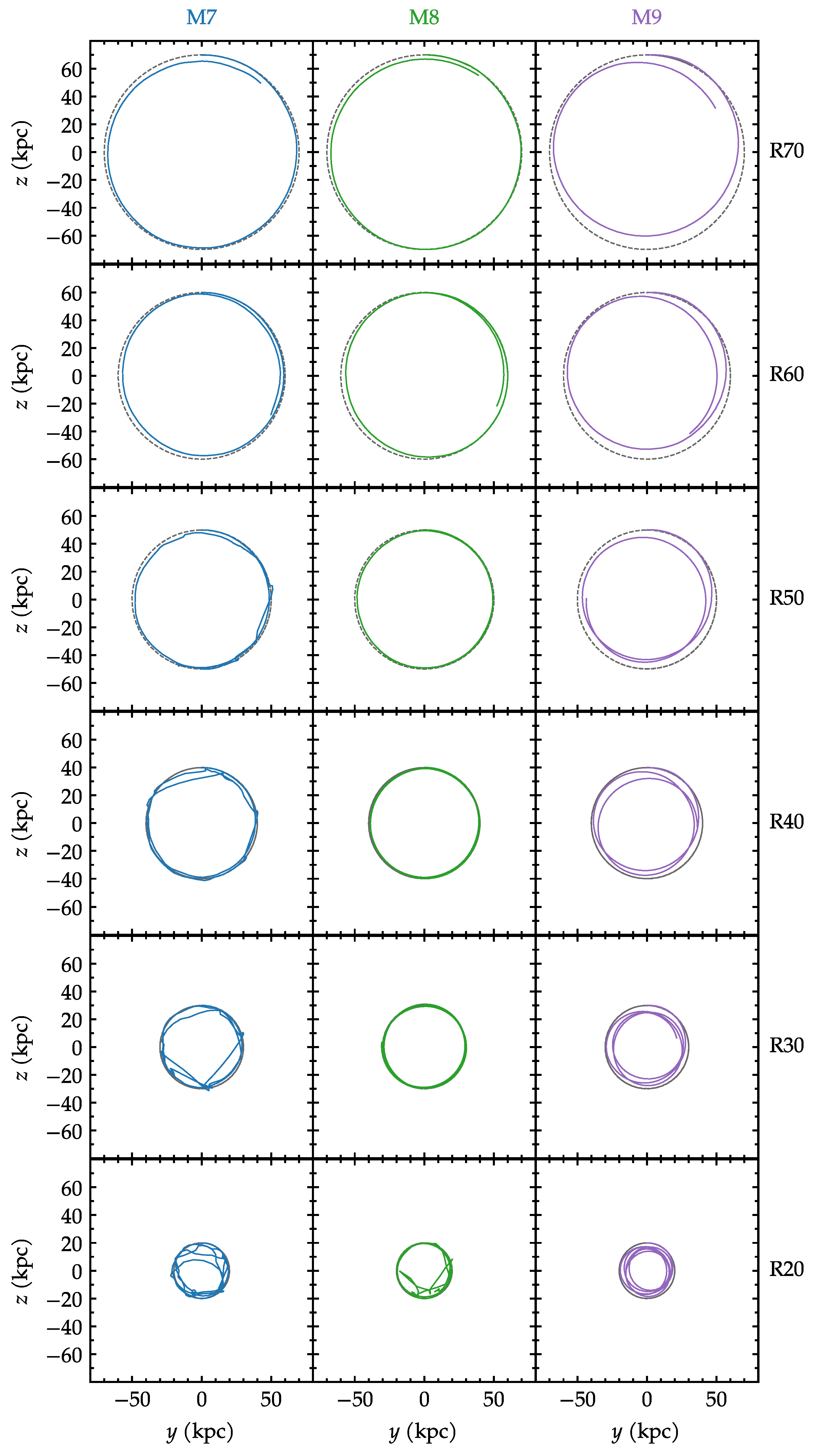
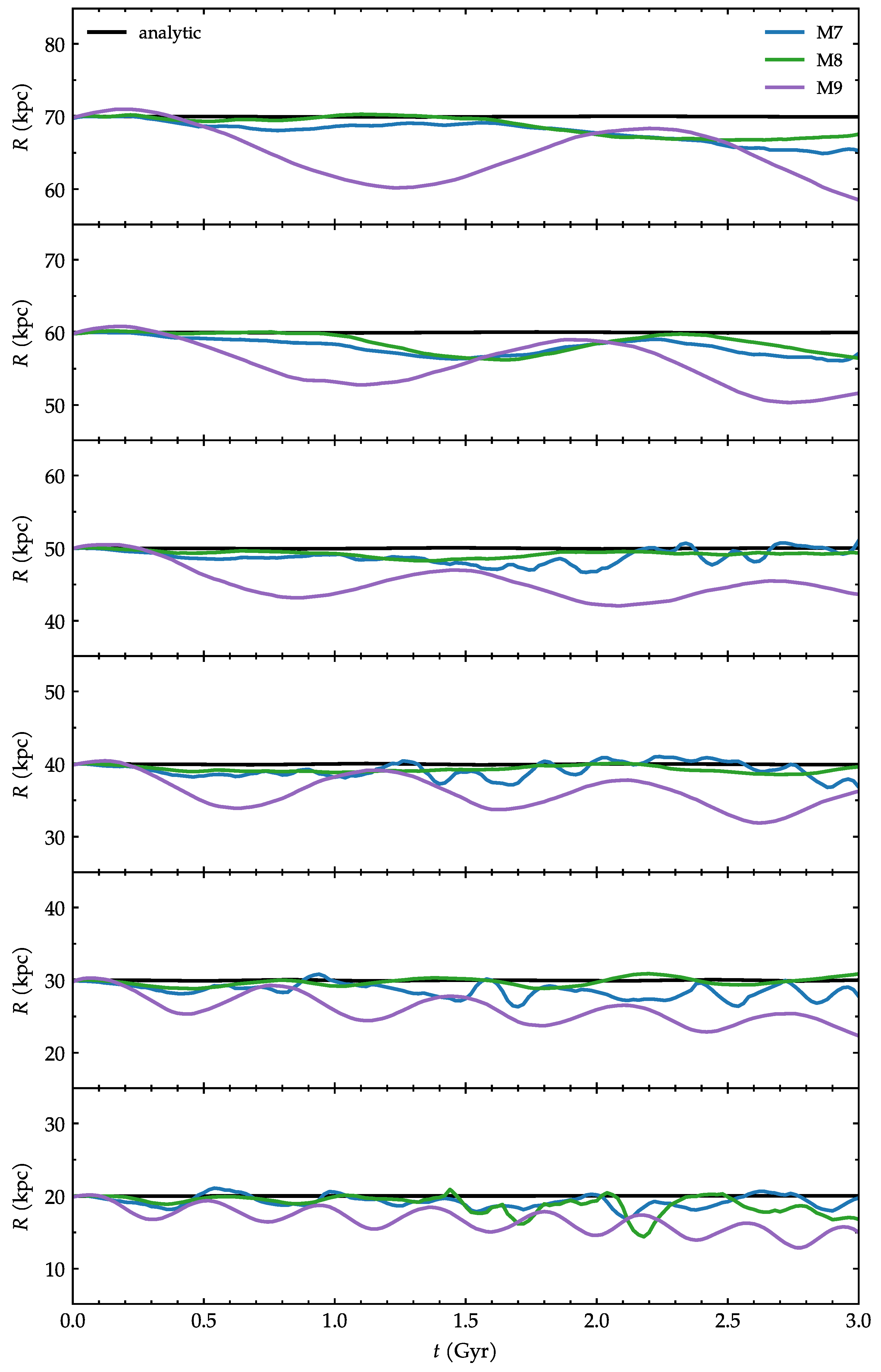


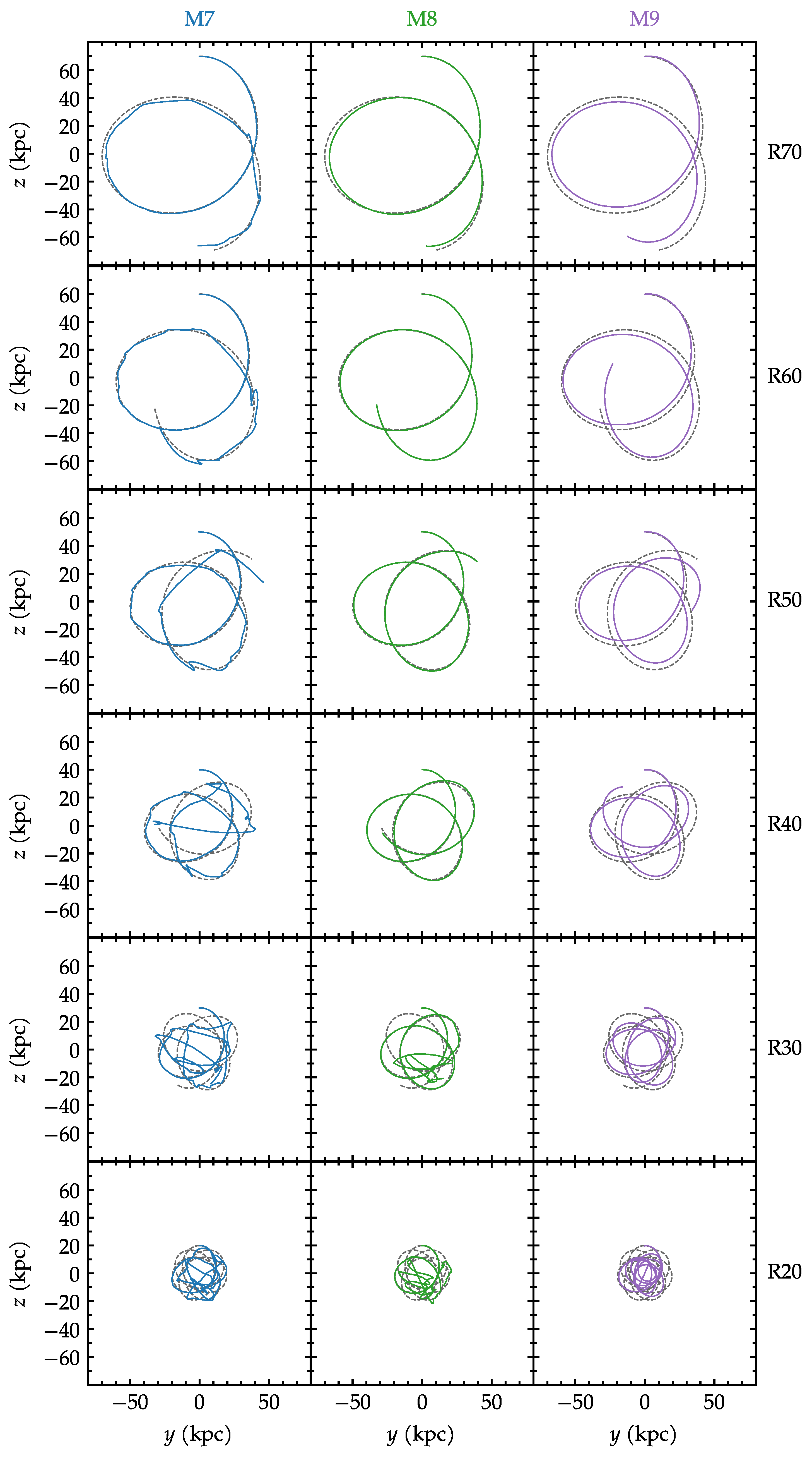
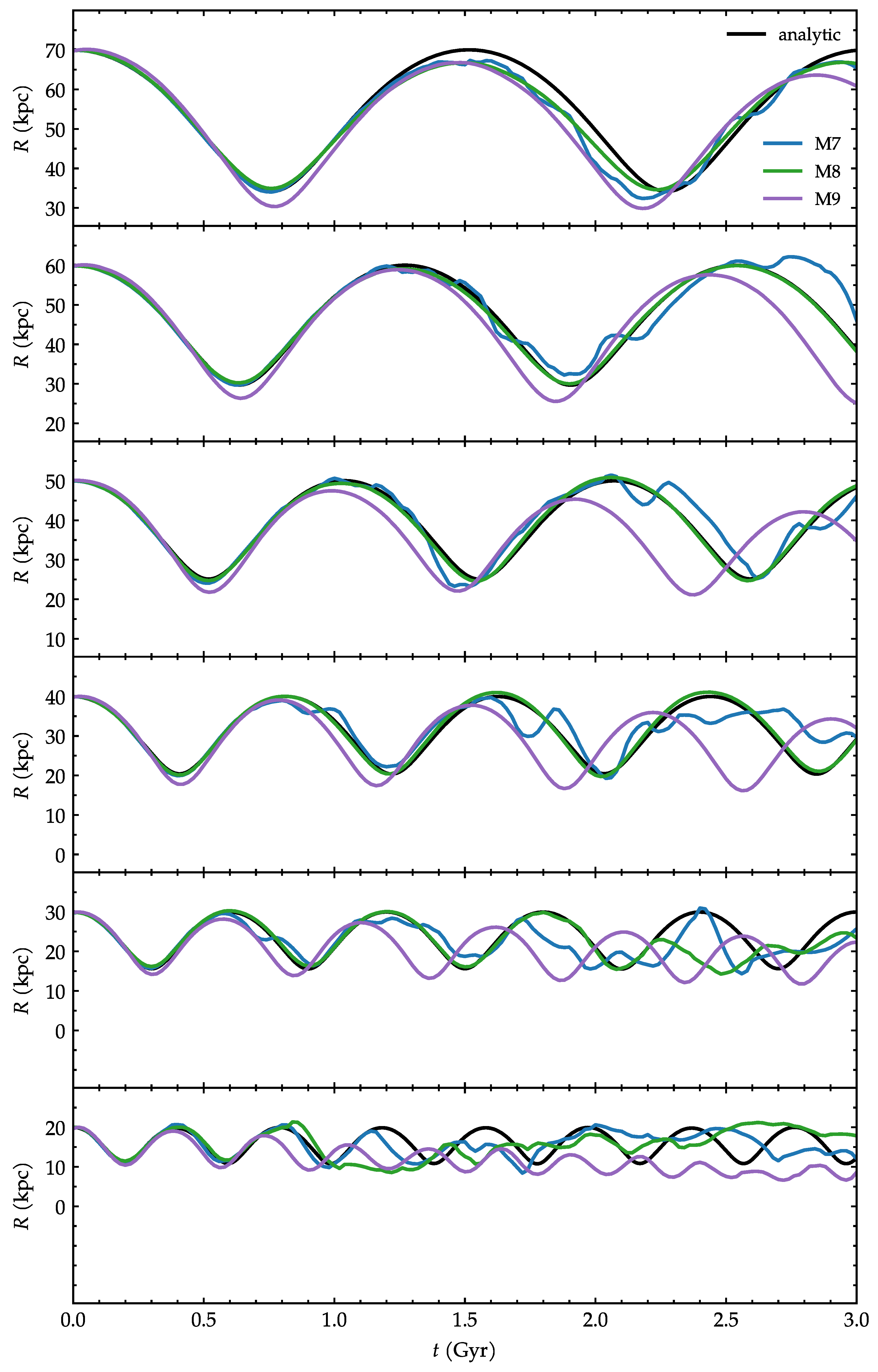
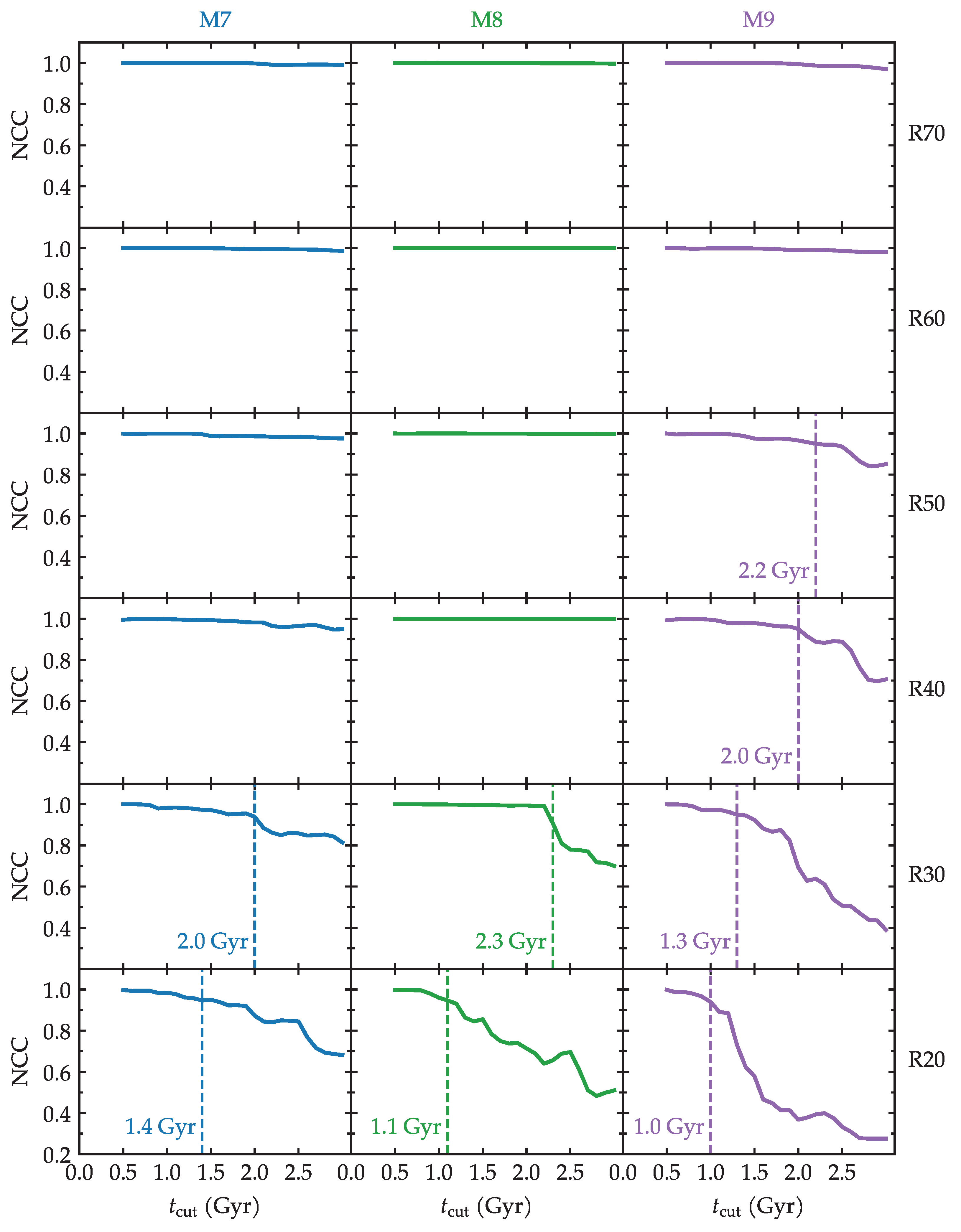

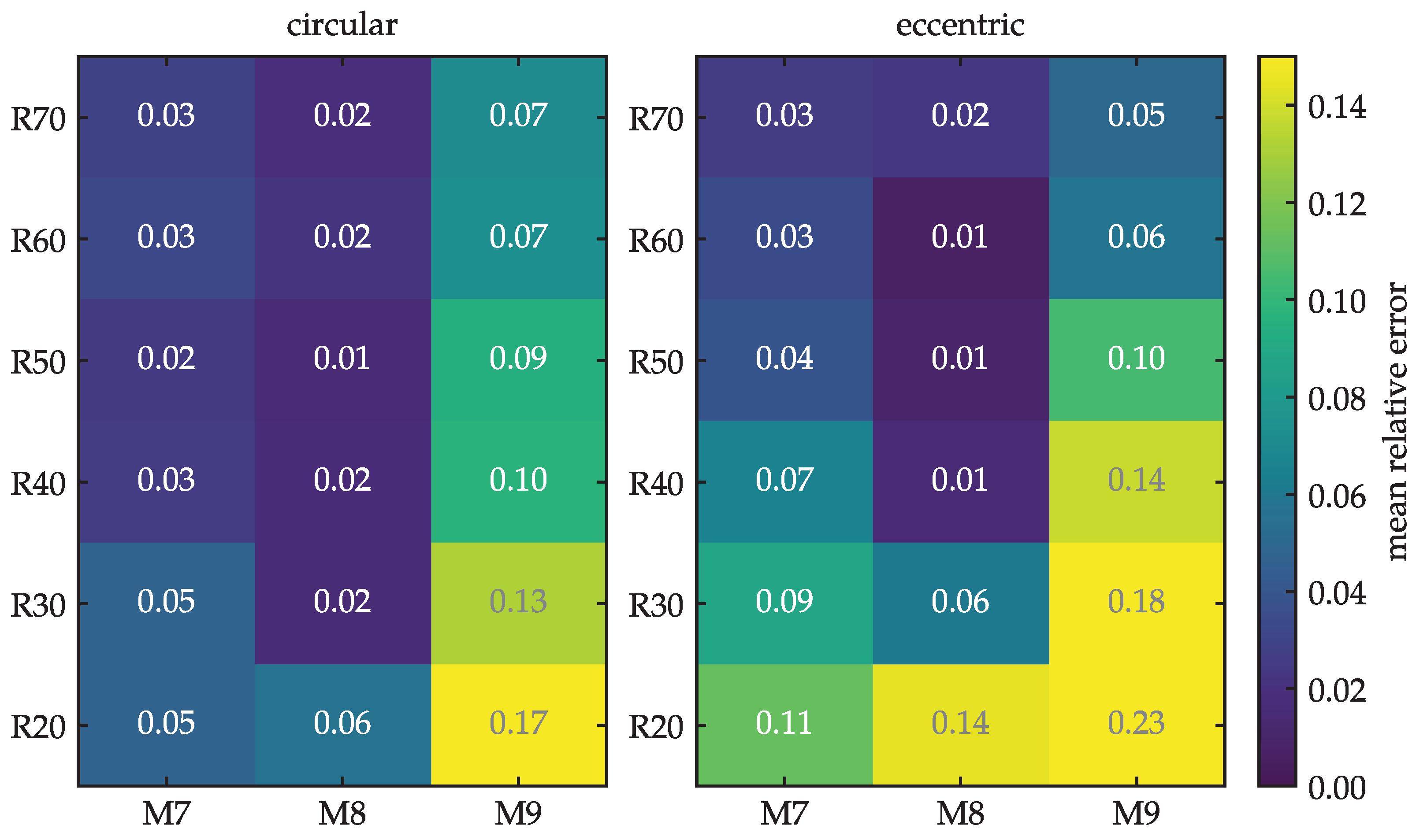

| Circular | Eccentric | |
|---|---|---|
| (kpc) | ||
| 20 | 168 | 117 |
| 30 | 166 | 116 |
| 40 | 164 | 115 |
| 50 | 161 | 112 |
| 60 | 157 | 110 |
| 70 | 154 | 108 |
| Label | Orbit Type | ||
|---|---|---|---|
| () | (kpc) | ||
| M7R20c | 20 | circular | |
| M7R30c | 30 | circular | |
| M7R40c | 40 | circular | |
| M7R50c | 50 | circular | |
| M7R60c | 60 | circular | |
| M7R70c | 70 | circular | |
| M8R20c | 20 | circular | |
| M8R30c | 30 | circular | |
| M8R40c | 40 | circular | |
| M8R50c | 50 | circular | |
| M8R60c | 60 | circular | |
| M8R70c | 70 | circular | |
| M9R20c | 20 | circular | |
| M9R30c | 30 | circular | |
| M9R40c | 40 | circular | |
| M9R50c | 50 | circular | |
| M9R60c | 60 | circular | |
| M9R70c | 70 | circular | |
| M7R20e | 20 | eccentric | |
| M7R30e | 30 | eccentric | |
| M7R40e | 40 | eccentric | |
| M7R50e | 50 | eccentric | |
| M7R60e | 60 | eccentric | |
| M7R70e | 70 | eccentric | |
| M8R20e | 20 | eccentric | |
| M8R30e | 30 | eccentric | |
| M8R40e | 40 | eccentric | |
| M8R50e | 50 | eccentric | |
| M8R60e | 60 | eccentric | |
| M8R70e | 70 | eccentric | |
| M9R20e | 20 | eccentric | |
| M9R30e | 30 | eccentric | |
| M9R40e | 40 | eccentric | |
| M9R50e | 50 | eccentric | |
| M9R60e | 60 | eccentric | |
| M9R70e | 70 | eccentric |
Disclaimer/Publisher’s Note: The statements, opinions and data contained in all publications are solely those of the individual author(s) and contributor(s) and not of MDPI and/or the editor(s). MDPI and/or the editor(s) disclaim responsibility for any injury to people or property resulting from any ideas, methods, instructions or products referred to in the content. |
© 2025 by the authors. Licensee MDPI, Basel, Switzerland. This article is an open access article distributed under the terms and conditions of the Creative Commons Attribution (CC BY) license (https://creativecommons.org/licenses/by/4.0/).
Share and Cite
Machado, R.E.G.; Tauil, G.C.; Schweder-Souza, N. Accuracy of Analytic Potentials for Orbits of Satellites Around a Milky Way-like Galaxy: Comparison with N-Body Simulations. Universe 2025, 11, 191. https://doi.org/10.3390/universe11060191
Machado REG, Tauil GC, Schweder-Souza N. Accuracy of Analytic Potentials for Orbits of Satellites Around a Milky Way-like Galaxy: Comparison with N-Body Simulations. Universe. 2025; 11(6):191. https://doi.org/10.3390/universe11060191
Chicago/Turabian StyleMachado, Rubens E. G., Giovanni C. Tauil, and Nicholas Schweder-Souza. 2025. "Accuracy of Analytic Potentials for Orbits of Satellites Around a Milky Way-like Galaxy: Comparison with N-Body Simulations" Universe 11, no. 6: 191. https://doi.org/10.3390/universe11060191
APA StyleMachado, R. E. G., Tauil, G. C., & Schweder-Souza, N. (2025). Accuracy of Analytic Potentials for Orbits of Satellites Around a Milky Way-like Galaxy: Comparison with N-Body Simulations. Universe, 11(6), 191. https://doi.org/10.3390/universe11060191







